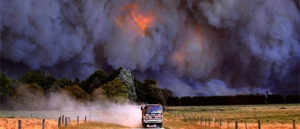Professor Jamie Kirkpatrick, supported by five co-authors, makes a spirited attack on timber harvesting (Logging has a clear link to bushfires, 8 June). That is unfortunate because it overshadows the very real issue of how we manage our fire-prone landscape.
Kirkpatrick attacks a peer-reviewed paper that I wrote, together with six co-authors, Timber harvesting does not increase fire risk and severity in wet eucalypt forests of Southern Australia.
Our paper was published in the international journal Conservation Letters.
Our landscape-scale study was based on an area analysis of all age-classes of mountain ash forest that burnt in the 2009 Kilmore and Murrindindi fires. Our study demonstrated conclusively that the Kilmore and Murrindindi fires burnt through forests irrespective of their tenure. It mattered not if the forest was managed for timber harvesting or national park or any other value – all of these areas burnt with the exception of some young post-harvesting regrowth. It is equally obvious that the recent fires in 2019-20 burnt through hundreds of thousands of hectares of national parks, distant and remote from timber harvesting areas.
Kirkpatrick et al. disagreed with our statement: “There is no evidence from recent megafires in Victoria that younger regrowth (less than 10 years) burnt with greater severity than older forest (over 70 years)”, claiming that our study ‘”Did not address the key period of flammability found by other studies, between around years 10 and 40.”
In fact, our study covered the whole range of years from 1900 to 2009. Our study remains far more robust than the selective studies preferred by Kirkpatrick et al. that largely ignore area and extent.
The blaming of fire damage on logging is especially galling for the fire-impacted region of East Gippsland. Two of the fires that were part of the devastation could not be contained during a month of relatively benign fire weather due to shortages of trained forest firefighters, bulldozers and other heavy equipment caused in part by large-scale reductions in the local timber industry.
It is unfortunate that Kirkpatrick attempts to belittle not only our science but also our academic standing. Kirkpatrick writes of our paper: “The logging industry funded a contradictory piece (contradictory to a study by Professor Lindenmayer, also published in Conservation Letters) on fire behaviour in 2014, using members of a group called the Institute of Foresters of Australia. The paper (was) led by Peter Attiwill, with co-authors employed by the logging industry.”
Wrong or misleading on all counts.
A: This was a collaboration between experts in forest science and forest fire management.
B: I am not a member of the Institute of Foresters of Australia; some of my co-authors may well be. Our research has no association whatsoever with that institute, and
D: Our backgrounds are universities, CSIRO bushfire research and state forest management agencies from Western Australia, Tasmania and Victoria.
It is wholly appropriate to involve forest and fire scientists from state forest agencies that manage timber production as they live and work in these forests and know what makes a real difference to fire management.
As we emphasised in our paper, “whether or not forests are harvested” is not the critical question. The wet eucalypt forests of southern Australia build up huge amounts of fuel. The critical question therefore remains: how do we manage for bushfires burning during extreme weather and protect both endangered natural and economic resources?
Peter Attiwill is Associate Professor, School of Botany, University of Melbourne (retired).
- Co-authored by Michael Ryan, Forest Scientist, VicForests, Victoria;
- Dr Neil Burrows, FireNinti Consultancy, formerly Director of Science, WA Department of Conservation and Land Management, and Department of Environment and Conservation;
- Phil Cheney, Leader, CSIRO Bushfire Research (retired);
- Lachie McCaw, Senior Principal Research Scientist, Department of Biodiversity, Conservation and Attractions, Western Australia;
- Mark Neyland, Manager, Centre for Forest Value, University of Tasmania.
This article was first published in The Age.






